
East Liberty Presbyterian Church, sometimes referred to as the Cathedral of Hope, is in the East Liberty neighborhood of the East End of Pittsburgh, Pennsylvania, United States. The current building is the fifth church building to occupy the site; the first was in 1819.
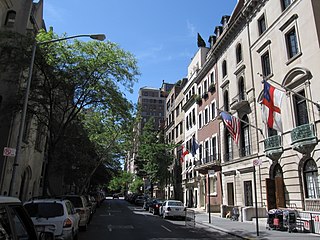
The Upper East Side, sometimes abbreviated UES, is a neighborhood in the borough of Manhattan in New York City, bounded approximately by 96th Street to the north, the East River to the east, 59th Street to the south, and Central Park and Fifth Avenue to the west. The area incorporates several smaller neighborhoods, including Lenox Hill, Carnegie Hill, and Yorkville. Once known as the Silk Stocking District, it has long been the most affluent neighborhood in New York City.
The Vanderbilt family is an American family who gained prominence during the Gilded Age. Their success began with the shipping and railroad empires of Cornelius Vanderbilt, and the family expanded into various other areas of industry and philanthropy. Cornelius Vanderbilt's descendants went on to build grand mansions on Fifth Avenue in New York City; luxurious "summer cottages" in Newport, Rhode Island; the palatial Biltmore House in Asheville, North Carolina; and various other opulent homes. The family also built Berkshire cottages in the western region of Massachusetts; examples include Elm Court.
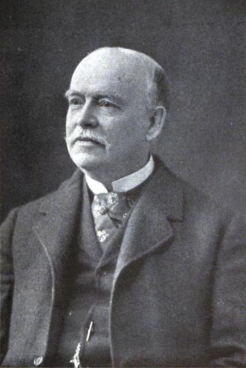
Josiah Cleaveland Cady or J. Cleaveland Cady, was an American architect known for his designs in Romanesque and Rundbogenstil styles. He was also a founder of the American Institute of Architects.

Richard Morris Hunt was an American architect of the nineteenth century and an eminent figure in the history of architecture of the United States. He helped shape New York City with his designs for the 1902 entrance façade and Great Hall of the Metropolitan Museum of Art, the pedestal of the Statue of Liberty, and many Fifth Avenue mansions since destroyed.

Weill Cornell Medical Center, previously known as New York Hospital or Old New York Hospital or City Hospital, is a research hospital in New York City. It is part of NewYork-Presbyterian Hospital and the teaching hospital for Cornell University.

Russell Risley Sage was an American financier, railroad executive and Whig politician from New York, who became one of the richest Americans of all time. As a frequent partner of Jay Gould in various transactions, he amassed a fortune. Olivia Slocum Sage, his second wife, inherited his fortune, which was unrestricted for her use. In his name she used the money for philanthropic purposes, endowing a number of buildings and institutions to benefit women's education: she established the Russell Sage Foundation in 1907 and founded the Russell Sage College for women in 1916.
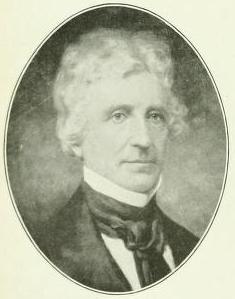
Harmar Denny was an American businessman and Anti-Masonic member of the U.S. House of Representatives from Pennsylvania.

John Stewart Kennedy was a Scottish-born American businessman, financier and philanthropist. He was a member of the Jekyll Island Club on Jekyll Island, Georgia along with J.P. Morgan and William Rockefeller among others.
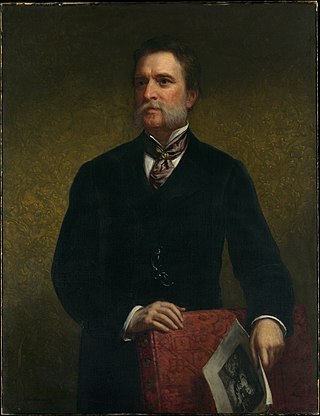
John Taylor Johnston was an American businessman and patron of the arts. He served as president of the Central Railroad of New Jersey and was one of the founders of The Metropolitan Museum of Art.

The history of Indianapolis spans three centuries. Founded in 1820, the area where the city now stands was originally home to the Lenape. In 1821, a small settlement on the west fork of the White River at the mouth of Fall Creek became the county seat of Marion County, and the state capital of Indiana, effective January 1, 1825. Initially the availability of federal lands for purchase in central Indiana made it attractive to the new settlement; the first European Americans to permanently settle in the area arrived around 1819 or early 1820. In its early years, most of the new arrivals to Indianapolis were Europeans and Americans with European ancestry, but later the city attracted other ethnic groups. The city's growth was encouraged by its geographic location, 2 miles (3.2 km) northwest of the state's geographic center. In addition to its designation as a seat of government, Indianapolis's flat, fertile soil, and central location within Indiana and the Midwest, helped it become an early agricultural center. Its proximity to the White River, which provided power for the town's early mills in the 1820s and 1830s, and the arrival of the railroads, beginning in 1847, established Indianapolis as a manufacturing hub and a transportation center for freight and passenger service. An expanding network of roads, beginning with the early National Road and the Michigan Road, among other routes, connected Indianapolis to other major cities.

Carl Pfeiffer (1834-1888) was a German American architect practicing in New York City.
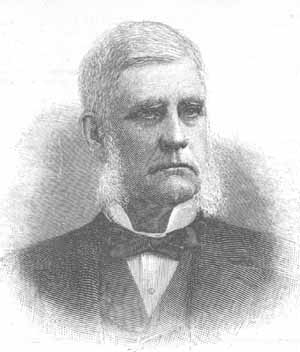
Sidney Dillon was an American railroad executive and one of the US's premier railroad builders.

The Allerton Hotel for Women, today known as Hotel 57, is a hotel located at 130 East 57th Street in the New York City borough of Manhattan. It is a seventeen-story brick, limestone, and terra cotta building designed by Arthur Loomis Harmon in 1920. It was built on the southwest corner of Lexington Avenue and 57th Street by the Allerton House Company at a cost of $700,000. It originally had stores on its ground floor. The hotel intended to accommodate six hundred business and professional women and also shelter young girls. When completed in 1923, the Allerton Hotel had room for four hundred tenants. Its occupancy was filled prior to completion and there was a long waiting list. After opening it was so popular that another establishment of its kind was anticipated.

Fifth Avenue Presbyterian Church is a Presbyterian Church (U.S.A.) church in New York City. The church, on Fifth Avenue at 7 West 55th Street in Midtown Manhattan, has approximately 2,200 members and is one of the larger PCUSA congregations. The church, founded in 1808 as the Cedar Street Presbyterian Church, has been at this site since 1875.

Wilson Brothers & Company was a prominent Victorian-era architecture and engineering firm based in Philadelphia, Pennsylvania. The company was regarded for its structural expertise.
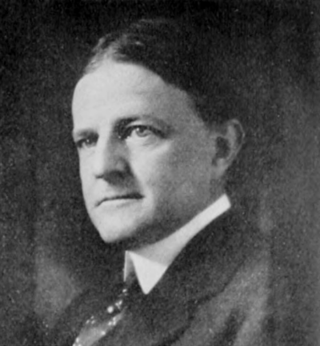
Howard Augustus Taylor was a tennis player from the United States.
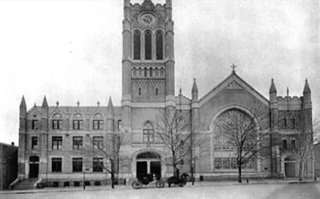
The congregation of North Presbyterian Church, at 525 West 155th Street in Manhattan, New York City, is a combination of three former congregations: North Presbyterian Church, Washington Heights Presbyterian Church, and St. Nicholas Avenue Presbyterian Church.
Morton Freeman Plant was an American financier.

Elliott Fitch Shepard was a New York lawyer, banker, and owner of the Mail and Express newspaper, as well as a founder and president of the New York State Bar Association. Shepard was married to Margaret Louisa Vanderbilt, who was the granddaughter of philanthropist, business magnate, and family patriarch Cornelius Vanderbilt. Shepard's Briarcliff Manor residence Woodlea and the Scarborough Presbyterian Church, which he founded nearby, are contributing properties to the Scarborough Historic District.

















